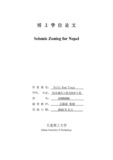Please use this identifier to cite or link to this item:
http://archive.nnl.gov.np:8080/handle/123456789/286| Title: | Seismic zoning for Nepal |
| Authors: | Thapa, Dilli Ram |
| Keywords: | Seismic Zonation Potential Seismic Source Zone Seismicity Seismic Hazard Analysis Peak Ground Acceleration Pattern Recognition Nepal |
| Issue Date: | 25-Feb-2018 |
| Abstract: | Nepal is exposed to high seismic risk from local and distant earthquakes and it is one of the well-identified earthquake-prone countries in the world. It has experienced two great seismic events with magnitudes equal to 8.1 and above (Mw = 8.1, 1505 and Mw = 8.4, 1934 Bihar-Nepal) during the past six centuries with huge economic losses, material damage and human casualties. In addition to these two historical great earthquakes, Nepal has often suffered extensive material damage and enormous economic losses by numerous instrumental strong seismic events, including the September 18, 2011 (M = 6.8) seismic event. The area in and around Nepal is seismically active and such damaging events are likely to continue in the future, therefore, it is essential to identify earthquake-prone areas and prepare the seismic zonation maps of Nepal that provide strong seismic ground motion parameters for the government, engineers, scientists and others for planning and design of anti-seismic key infrastructures and emergency management in order to reduce the casualties and economic losses from future earthquake disasters in this region. The aim of this dissertation is to prepare a set of seismic zonation maps for Nepal. This dissertation primarily composed of three studies. The first study is specifically devoted to the analysis of earthquake catalogue. All the available historical and instrumental earthquakes with magnitudes equal to or greater than 4.0 that occurred in the region defined between latitudes 26°N and 31.7°N and longitudes 79°E and 90°E from 1255 to 2011 were compiled. The analysis of compiled earthquake database was carried out very carefully reviewing published literatures and duplicated seismic events, aftershocks and foreshocks were removed. By using the published empirical relations, different magnitudes (Ms, Mb, and ML) and intensity scales were converted into the surface-wave magnitude and finally, an unified and homogeneous catalogue of earthquakes (in terms of surface-wave magnitude, Ms ≥ 4.0) was prepared. The analysis of seismic catalogue (Ms ≥ 4.0) spanning the period 1255-2011 shows that earthquakes are unevenly distributed in the study area with the strongest earthquake activity in the far-western and eastern parts of the country and the weakest seismic activity in southern Nepal. Furthermore, the spatial association of earthquakes with major faults demonstrates that the epicenters of the overwhelming number of seismic events are situated near the surface trace of Main Central Thrust (MCT) and epicenters of a few earthquakes are situated at small distances from the surface traces of the Main Boundary Thrust (MBT) and the Main Frontal Thrust (MFT) in this study area. In the second study, earthquake-prone areas in the Nepal Himalaya and the surrounding regions were determined using the morphostructural zoning (MSZ) and pattern recognition techniques (PRT). The determination of location of future seismically dangerous areas using PRT in this dissertation shows that the majority of earthquake-prone areas are located on second rank lineaments than on the first and third rank lineaments in the investigation region. These identified potential earthquake-prone areas are also located in our study area where no records of strong seismic events (M ≥ 6.0) have been reported in the past. The third study is focused on defining potential seismic source zones and developing the seismic zonation maps of Nepal. Based on the distribution of catalogued earthquakes, distribution of faults and tectonic information, as well as earthquake-prone areas identified from the pattern recognition techniques, twenty-three potential seismic source zones were established for the study area. Integrating potential seismic source zone information and probabilistic earthquake hazard parameters (minimum magnitude, maximum magnitude and earthquake spatial distribution function for individual source zone, and b-value, average annual occurrence rate of earthquakes, hypocenter depth for the whole region) in conjunction with a selected PGA attenuation relationship, seismic ground motion hazard at bedrock level were calculated over a grid of 0.2° × 0.2° covering the entire territory of Nepal with 63%, 10%, and 2% probability of exceedance in 50 years. The resulting seismic zonation maps address earthquake ground motion hazard in terms of PGA at bedrock level with 63%, 10%, and 2% probability of exceedance in 50 years. These seismic zoning maps prepared at three different exceedance probabilities (63%, 10%, and 2%) generally reveal the high seismic ground motion hazard in the eastern and far-western segements of the country, and low seismic ground motion hazard in southern Nepal. In addition, the probabilistic seismic zonation maps prepared in this dissertation are compared with the seismic zoning maps of China and India. This comparison of our seismic zonation maps with the seismic zonation maps of neighboring countries indicate that the PGA values obtained in the present analysis well-match with those of PGA values shown in the seismic zonation map of India only in a particular area of high seismic ground motion hazard in the far-western part of Nepal. |
| Description: | Dalian University of Technology, 2014. |
| URI: | http://103.69.125.248:8080/xmlui/handle/123456789/286 |
| Appears in Collections: | 500 Natural sciences and mathematics |
Files in This Item:
| File | Description | Size | Format | |
|---|---|---|---|---|
| Thapa Dilli Ram 10906088.pdf | 2.03 MB | Adobe PDF |  View/Open |
Items in DSpace are protected by copyright, with all rights reserved, unless otherwise indicated.